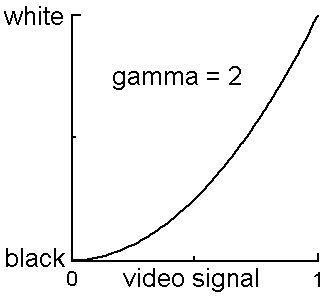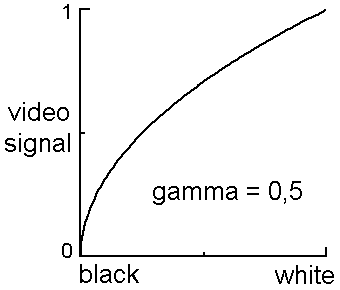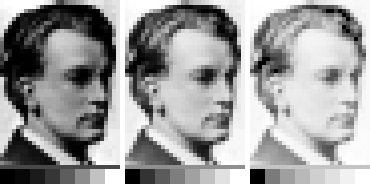Chapter 23
Gamma for NBTV
Broadcast standard TV systems use a principle called 'Gamma'. This principle can
also be usefully applied to NBTV video signals.
Picture tubes
Gamma relates to the reproduction of shades of grey. Television picture tubes
are far from linear. When a linear ramp video signal is applied, then the
brightness on the screen increases in a quadratic way. This is because of the
way cathode ray tubes work. Quadratic means to the power of 2. This power is
called the Gamma. A picture tube has a gamma of 2.

A picture tube has a gamma of 2.
Gamma correction
Correct grey scale reproduction requires correction for picture tube gamma.
This gamma correction is the inverse operation of quadratic, i.e. the square
root. Square root is the same as 'to the power ½', so the gamma corrector
has a gamma of ½ or 0.5.

To correct the picture tube a gamma of 1/2 is needed.
Historically the TV signal as transmitted has embodied this
correction. TV cameras, both professional and domestic, still incorporate this
correction with gamma equals ½.
Added noise
A TV system that uses gamma can be shown to have certain advantages over a
linear system. Our eyes are more sensitive to changes in brightness in dark
parts of a picture, than in bright parts. When a TV set receives a weak station
there is noise added to the received video signal. In a linear system the same
amount of added noise would be more visible in dark areas than in bright parts.
The gamma of the picture tube compresses the noise in the dark areas and expands
the noise in the bright parts of the picture. This compensates, more or less,
our eye's noise sensitivity curve.
Digital video
Noise is added not only due to weak reception. If video signals are digitised
this digitisation also adds noise: the so-called quantisation noise. This
quantisation noise is stronger if fewer bits per sample are used. Gamma
corrected video signals enable fewer bits to be used for digitisation than
linear video signals.
NBTV practice
A straight forward Nipkow disc televisor has a gamma of almost 1. Neon lamps and
LED's give light proportional (linear) to the applied current. If this televisor
is used to look at test patterns coming from our NBTV CD's you will observe that
the dark grey blocks can be distinguished very well, while the bright grey
blocks all seem to have the same brightness. There is a big difference if your
monitor is based on an oscilloscope. Its picture tube has a higher gamma, and
all grey blocks are clearly distinguishable.
Also in live video from the CD's the linear disc televisor shows the brighter
parts (e.g. faces) bleached out. If you lower the brightness setting you will
see that there is much more detail to see! This happens because the live video
of the CD was recorded from Peter Smith's camcorder, with gamma corrected
signals of course (gamma = ½), through his linear working scan converter.

camera gamma=1 . camera gamma=½ . camera gamma=½
monitor gamma=2 . monitor gamma=2 . monitor gamma=1.
darks almost black . . . correct greys . . . brights bleached out
Gamma in NBTV
For the satisfactory display of scan-converted NBTV video originating from
broadcast type sources with a gamma of ½ it is recommended that a gamma
correction of around 2 should be applied to the video signals in your monitor.
NBTV monitors employing cathode ray tubes, like oscilloscopes, have already a
built-in gamma of around 2 and therefore no gamma correction is needed.
Where monitors have a fixed gamma of around 2 it follows that all input sources,
including mechanical cameras, will theoretically require the inverse gamma
correction to be applied. Otherwise, the gamma correction would need to be made
switchable to cater for alternative input signals with varying amounts of gamma.
Gamma in a disc televisor
It is simple to build a disc televisor so that it displays grey levels as if it
had a gamma of 2. In previous chapters LED driver circuits are given. The three
resistors and two diodes in the circuit of the driver transistor are there to
introduce this non linearity. Correct selection of the resistor values ensures a
satisfactory display of grey scale gradations.
Computers
The same considerations apply in the world of computers. As LCD screens replace
cathode ray tube types their characteristics must be matched to pre-serve grey
scale and colour fidelity. It is sometimes possible to set the gamma of a
computer's video screen output in the display setting menu.
A typical NBTV viewer program will include a gamma adjustment alongside contrast
and brightness settings, allowing its effects to be clearly observed.


